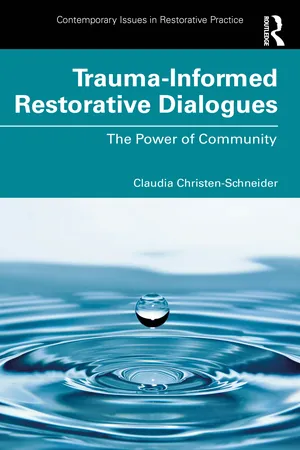
- 218 pages
- English
- ePUB (mobile friendly)
- Available on iOS & Android
About this book
This book combines trauma-informed practice with restorative justice to explore how restorative dialogues can support those affected by trauma. Trauma-informed practice involves understanding the impact of trauma and creating an environment that is sensitive to its effects, which is essential for fostering meaningful dialogue between victims and offenders. Conversely, restorative justice focuses on addressing harm through inclusive processes involving victims, offenders and the community, and aims to respond to the needs of all parties affected by the harm.
By integrating these perspectives, the book illustrates how trauma-informed restorative dialogues - an approach that expands access to restorative justice when direct encounters between victims and offenders are not possible - can improve access to justice, promote recovery and facilitate transformation. It provides practical guidance based on insights from victims and facilitators in five European countries and offenders in Swiss prisons, and addresses secondary trauma among practitioners, offering strategies for their self-care and organisational care.
Aimed at practitioners, academics, policy makers and service providers, this in-depth research fills a gap in the restorative justice literature by demonstrating how trauma-informed principles can strengthen communities and support those affected by serious harm.
Frequently asked questions
- Essential is ideal for learners and professionals who enjoy exploring a wide range of subjects. Access the Essential Library with 800,000+ trusted titles and best-sellers across business, personal growth, and the humanities. Includes unlimited reading time and Standard Read Aloud voice.
- Complete: Perfect for advanced learners and researchers needing full, unrestricted access. Unlock 1.4M+ books across hundreds of subjects, including academic and specialized titles. The Complete Plan also includes advanced features like Premium Read Aloud and Research Assistant.
Please note we cannot support devices running on iOS 13 and Android 7 or earlier. Learn more about using the app.
Information
Table of contents
- Cover
- Endorsements
- Half Title
- Series Page
- Title Page
- Copyright Page
- Table of Contents
- List of illustrations
- Acknowledgements
- 1. Laying the foundations
- 2. Situating restorative dialogues in context
- 3. Exploring restorative dialogues through the voices of lived experiences
- 4. Implementing restorative dialogues: Reflections from Switzerland
- 5. Being trauma-informed in restorative justice
- 6. Delivering trauma-informed restorative dialogues
- 7. Preventing and addressing secondary trauma
- 8. Final reflections and recommendations
- Appendix: Trauma and its effects on brain and body
- Index